Factors that predict discharge destination for patients in transitional care: a prospective observational cohort study
Natasha K. Brusco A B F , Nicholas F. Taylor A B , Ilana Hornung C , Shanandoah Schaffers D , Anna Smith E and Natalie A. de Morton AA La Trobe University, Bundoora, VIC 3186, Australia. Email: n.taylor@latrobe.edu.au, demortonn@ramsayhealth.com.au
B Eastern Health, 5 Arnold Street, Box Hill, VIC 3128, Australia.
C Western Health, 160 Gordon Street, Footscray, VIC 3011, Australia. Email: ilana.hornung@wh.org.au
D Peninsula Health, c/- Frankston Hospital, Hastings Road, Frankston, VIC 3199, Australia. Email: sschaffers@phcn.vic.gov.au
E Southern Health, 246 Clayton Road, Clayton, VIC 3168, Australia. Email: anna.smith@southernhealth.org.au
F Corresponding author. Email: nbrusco@cabrini.com.au
Submitted: 2 June 2011 Accepted: 5 March 2012 Published: 10 September 2012
Journal Compilation © AHHA 2012
Abstract
Objective. To investigate factors that predict discharge destination for patients making the transition from hospital to the community.
Methods. Using a prospective cohort design, 696 patients from 11 Transition Care Programs were recruited. Baseline patient and program characteristics were considered for predicting discharge destination, functional status, and patient length of stay.
Results. An increased physiotherapy staffing ratio in Transition Care Program was associated with an increased likelihood that a patient was discharged home, with an improved functional or mobility status, and after a shorter length of stay. The other factor that predicted discharge to home included having an Aged Care Assessment Service classification of low level care or home with a support package. An increased physiotherapy staffing level also reduced the likelihood of discharge to low level or high level care. The other factors that predicted discharge to low level care were having higher mobility status and older age; the other factor associated with increased likelihood of predicting discharge to high level care was having an Aged Care Assessment Service classification of high level care.
Conclusions. Factors on admission that predicted discharge destination were program physiotherapy staffing ratios, Aged Care Assessment Service assessment, age and mobility status.
What is known about the topic? In 2004/05 Australia introduced a program called the Transition Care Program (TCP), which targets older persons at the conclusion of an acute hospital episode who require more time and support in a non-acute setting to complete their restorative process and optimise their functional capacity. This program has a particular objective to prevent inappropriate admission to a residential aged care facility. To date, there are no published papers that report the factors that predict discharge destination for patients in the Transition Care Program.
What does this paper add? This study provides evidence that program physiotherapy staffing ratios, Aged Care Assessment Service assessment, age and mobility status are predictive of an increased likelihood that a patient will be discharged home with an improved functional/mobility status, after a shorter length of stay.
What are the implications for practitioners? Knowledge of factors that predict discharge destination may assist healthcare practitioners and health managers in managing TCP patients and planning services.
Additional keywords: aged care, function, mobility, physiotherapy, prediction factors, Transition Care Program.
Introduction
The concept of intermediate care was introduced in the United Kingdom in 2000 and was designed as a bridge between the hospital and community care.1 In 2004/05 Australia introduced a similar concept called the Transition Care Program (TCP).2 The TCP targets older persons at the conclusion of an acute hospital episode who require more time and support in a non-acute setting to complete their restorative process and optimise their functional capacity. Due to its flexible nature, the TCP model of care can vary between hospital, residential or community settings.4 Common to all programs however, is the provision of low intensity therapy, including physiotherapy, to maximise physical functioning.2
A particular objective of the TCP is prevention of inappropriate admission to a residential aged care facility.3 However, to date there is little evidence regarding the factors that predict discharge destination for patients in TCP. Knowledge of factors that help predict discharge destination have been established for the sub-acute setting.5,6 Identification of such predictive factors in TCP would provide useful information for healthcare practitioners and health managers providing and planning services for TCP, as has been demonstrated in other areas of healthcare.7 Therefore, the primary aim of this study was to identify the baseline factors that predict discharge destination after TCP admission. The secondary aims were to explore the factors that predict functional and mobility status at discharge, and length of stay on TCP. This was due to expectations that functional and mobility status attained at discharge might be related to discharge destination, and that a significant cost in providing TCP services is length of stay on the program.
Method
Study design and setting
This study was a multicentre prospective cohort observational study. The settings for the TCPs were a hospital inpatient ward, a residential care facility, and in the community, that is, the patient’s home. All 14 of the TCPs across Victoria and Tasmania were invited to participate in this study. However two TCP sites were excluded, due to vacant TCP physiotherapy positions, and a third due to insufficient managerial time for physiotherapists to complete the administrative duties required to obtain ethics approval and participate in this study. Eleven of the 14 sites provided written support for site participation and gained relevant ethics approval.
Participants
Patients were included if they were admitted to one of the 11 TCPs between October 2009 and April 2010 (6-month period) and received physiotherapy intervention during TCP stay. Since it is an aim of TCP to maximise physical functioning, that there is evidence that physiotherapy management improves functional outcomes in frail populations,8 and that patients in TCP typically have poor levels of functioning,9 we were interested in including one of the services that focuses on improving functioning, namely physiotherapy. Potential participants were excluded if physiotherapy intervention was not included as part of their management plan, and if they were not discharged until after the 6-month data collection period.
Intervention
Across the 11 TCP sites the usual physiotherapists, or allied health assistants under physiotherapist supervision, provided care. Participants also received usual care from all other members of the TCP, including but not limited to medical, nursing, care staff, and other allied health and support services. Usual care physiotherapy management may include mobility training, skill training exercise prescription, group exercise sessions, caregiver training, education and discharge planning. The physiotherapy management in the TCPs usually followed such elements, with the specific management left to the discretion of the treating physiotherapist, based on their individual assessment. To the authors’ knowledge there is no current standard evidence-based protocol for the provision of physiotherapy services in the TCP.
Outcome measures
The primary outcome was discharge destination, recorded at discharge as either home environment, low level residential care, high level residential care, or other (which included transfer back to an acute hospital facility, a hospital sub-acute rehabilitation facility, or death).
The secondary outcomes were Modified Barthel Index10 (MBI) as a measure of function, the de Morton Mobility Index (DEMMI)11 as a measure of mobility, and length of stay. The widely used MBI was developed as a multidimensional measure of a patient’s ability to perform activities of daily living.10 The recording of a patient’s MBI on admission and discharge is a mandatory requirement of the TCP.9 The DEMMI is a 15 item uni-dimensional measure of patient mobility.11 There is evidence that both DEMMI and MBI are valid measures of activity limitation for patients in TCP.12
Data Collection
At admission, baseline factors were recorded, including age, gender, diagnosis, Aged Care Assessment Service (ACAS) classification, TCP setting, co-morbidities as a measure of the Charlson Co-morbidities Index,13 gait aid, MBI, DEMMI and Physiotherapy staff: patient ratios. Physiotherapy staff: patient ratios were calculated based on the average staffing equivalent full time positions at the time the data collection commenced, relative to the total bed numbers for the corresponding program at this time. The staffing included qualified physiotherapists and allied health assistants that were providing physiotherapy interventions under the direction of the physiotherapist.
Upon discharge, additional factors were recorded, including the patient length of stay and the number of physiotherapy interventions. Assessments were completed at admission and discharge by the usual care physiotherapy staff.
Length of stay was based on the number of overnight stays in TCP. Usual care physiotherapy was provided to the patients in TCP with the number of sessions recorded. To allow exploration of the relationship between physiotherapy staffing ratios and the amount of therapy received, the number of physiotherapy sessions per week for a patient was calculated by dividing the total number of physiotherapy sessions by the number of weeks that the patient was admitted to the TCP.
Statistical analysis
Regression modelling with covariates was performed for each outcome14 using SPSS version 17.0a.15 Linear regression analyses (ANCOVA) were applied for continuous outcomes (length of stay, discharge DEMMI and discharge MBI), and a linear mixed logistic regression analysis for dichotomous outcomes for discharge destination (home compared with other, low level residential care compared with other, high level residential care compared with other). The following baseline variables were used as potential covariates; age, gender, diagnosis, ACAS classification, TCP setting, co-morbidities as a measure of the Charlson Co-morbidities Index,13 gait aid on admission, MBI, DEMMI and Physiotherapy staff: patient ratios. Physiotherapy staff: patient ratios were included as a centre factor in the linear mixed logistic regression analysis. Variables were included as covariates if found to be significantly correlated with the outcome of interest, were not collinear, and were statistically significant in the final regression model. The large sample obtained in this study provided a more than adequate ratio of ‘cases to variables’ for the planned modelling.16
The relationship between physiotherapy staffing ratio and physiotherapy sessions received each week was explored with Pearson’s product moment correlation.
Results
The 11 TCP sites that participated in this study included a total of 436 beds, and Fig. 1 demonstrates the flow of patients through the study. The summary of data on admission and on discharge is presented in Table 1.
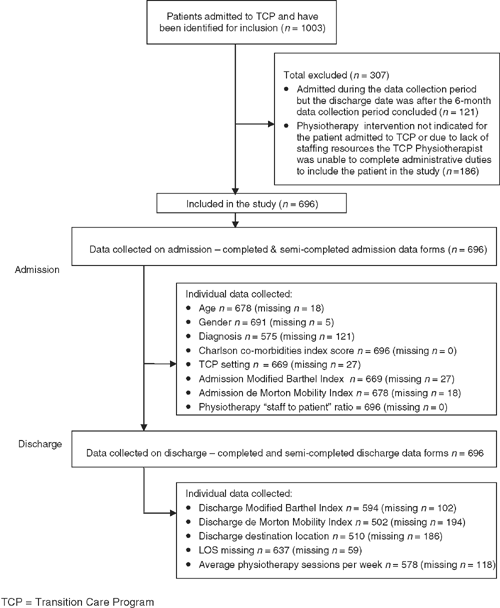
|
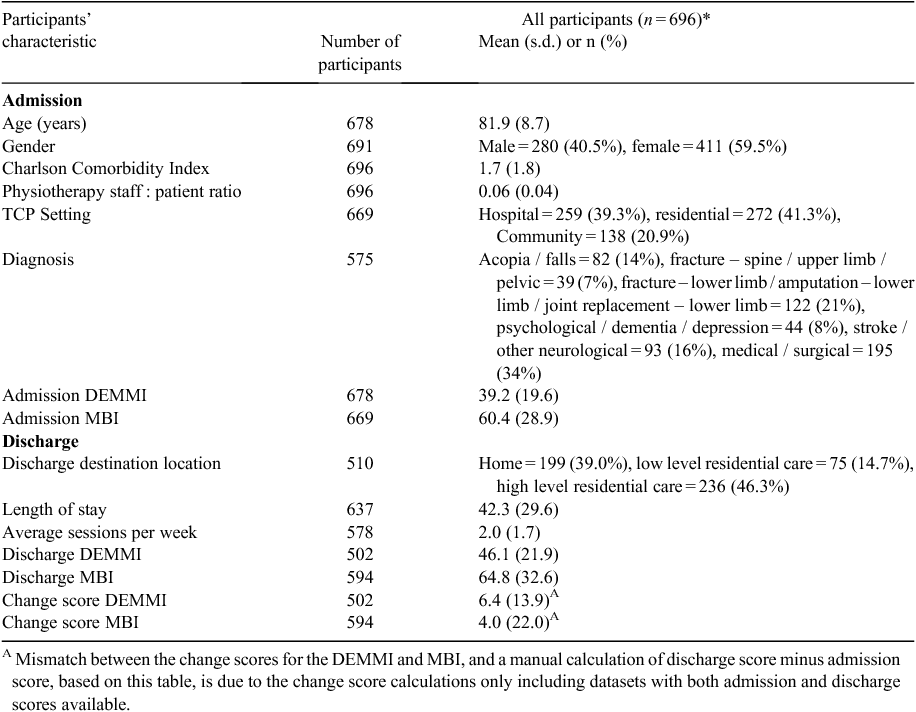
|
Primary outcomes
Physiotherapy staffing ratios and ACAS admission assessments were significant factors in determining whether a TCP participant was discharged to home compared with another place of accommodation. Participants who received a low level care, or a home with community support ACAS assessment, and who were in a program with a higher physiotherapy staffing ratio were more likely to be discharged home, than were those who had a high level residential care ACAS assessment and were in a program with a lower physiotherapy staffing ratio (Table 2).
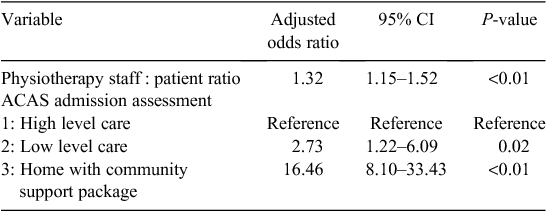
|
Physiotherapy staffing ratios, and participant age and DEMMI score on admission were significant factors in determining whether a TCP participant was discharged to low level residential care rather than another place of accommodation. Participants who had higher DEMMI scores (i.e. higher levels of mobility), were older, and were in a program with a lower physiotherapy staffing ratio, were more likely to be discharged to low level residential care than were those who had a lower DEMMI score, were younger and were in a program with a higher physiotherapy staffing ratio (Table 3).

|
Physiotherapy staffing ratio and ACAS admission assessments were significant factors in determining whether a TCP patient was discharged to high level residential care rather than another place of accommodation. Participants who received a high level residential care assessment, and who were in a program with a lower physiotherapy staffing ratio, were more likely to be discharged to high level residential care than were those who had a low level residential care assessment and were in a program with a higher physiotherapy staffing ratio (Table 4).
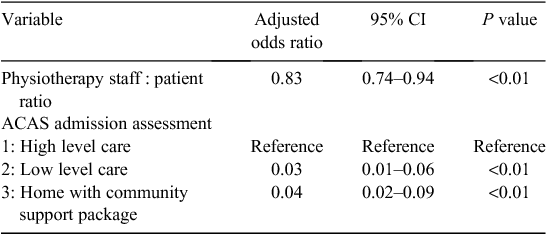
|
Of the 10 baseline factors, neither gender, comorbidities, TCP setting, admission gait aid, MBI nor diagnosis were significant predictors of discharge destination.
Secondary outcomes
Significant factors that determined patient discharge mobility status, as measured by the DEMMI, were the DEMMI score on admission and the physiotherapy staffing ratio. Participants who had higher DEMMI scores and who were in a program with a higher physiotherapy staffing ratio were more likely to have a higher discharge DEMMI score than those who had a lower DEMMI score on admission and were in a program with a lower physiotherapy staffing ratio (Table 5).
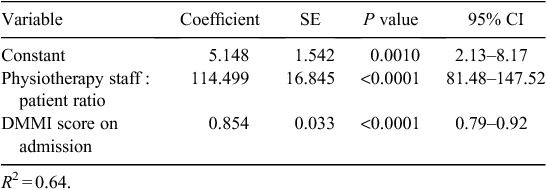
|
Significant factors that determined the patient discharge functional status, as measured by the MBI, were the MBI score on admission, and physiotherapy staffing ratio. Participants who had higher MBI scores and who were in a program with a higher physiotherapy staffing ratio were more likely to have a higher discharge MBI score than those who had a lower MBI score on admission and were in a program with a lower physiotherapy staffing ratio (Table 6).
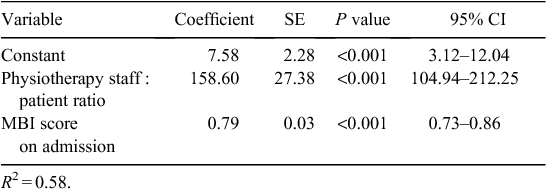
|
Significant factors that determined the patient length of stay were the TCP setting on admission and the physiotherapy staffing ratio. Participants who were in the hospital setting on admission and were in a program with a higher physiotherapy staffing ratio were more likely to have a shorter length of stay than those who were in the residential care setting or community setting and were in a program with a lower physiotherapy staffing ratio (Table 7).

|
The ratio of physiotherapy staff to patients ranged from 0.02 to 0.18 with a mean of 0.06 (s.d. 0.04) in the 11 programs, and the mean intensity of physiotherapy intervention was 2.00 sessions (i.e. consultations) per week (s.d. 1.75) across the 578 trial participants for whom this outcome was reported. The correlation between physiotherapy staffing ratio and the intensity of weekly physiotherapy interventions was r = 0.80.
Discussion
Physiotherapy staffing ratio was a consistent factor that predicted discharge destination to home, low level residential care and high level residential care. Participants who were in a program with a higher ratio of physiotherapy staffing were more likely to return home and less likely to be discharged to residential care. The physiotherapy staffing ratio was highly correlated with the number of weekly sessions of physiotherapy received during the TCP admission episode. The results of this study do not mean that the increased staffing ratios caused the positive outcomes. However this is one explanation; that greater improvements in mobility and function were associated with increased staff ratios and more regular treatment sessions, and that improved mobility and function led, in turn, to more positive discharge outcomes.
There is evidence that physiotherapy can have a positive effect on a range of patient outcomes in other settings.17–19 It has also been shown that increasing the amount of physiotherapy, such as providing an increased number of weekly sessions, can have a positive association with improving other patient outcomes in acute and sub-acute settings.20,21 The results from the current study in the TCP setting is consistent with those from previous research, in that an increased amount of physiotherapy is associated with improved patient and health service outcomes. The specific type of physiotherapy intervention potentially varied between TCPs, and contained elements of the following aspects of physiotherapy management: mobility training, skill training exercise prescription, group exercise sessions, caregiver training, education and discharge planning.
The results of the current study are consistent with the 2008 National Evaluation of the Transition Care Program Final Evaluation Report, which reported that higher allied health staffing hours were associated with better patient outcomes.9 The report found that the risk of residential aged care admission decreased by 21% for every additional hour of allied health services per place per week in TCP.9 Our results may be useful in providing further evidence to inform health service managers of the specific impact of physiotherapy staffing ratios. Our results may also be useful for the purpose of reviewing physiotherapy staffing levels in current TCPs or in deciding upon such levels for new TCPs as they are established.
If the positive predictive relationship between increased staffing ratios and TCP outcomes is confirmed with an intervention study, there would be clinically significant benefits to both the health service and the patient. For the health service, the cost of additional physiotherapy services could be balanced against the cost savings of a shorter length of stay. This reduction in length of stay could reduce the total cost per patient admission and directly impact waiting lists, with the potential to service more patients per year with greater patient output. Higher levels of mobility and function at discharge were observed for patients who had a higher ratio of physiotherapy, and more of these patients returned to the home environment rather than other discharge destinations. However, factors other than physiotherapy staffing ratios were associated with a reduced length of stay, and these should also be considered. For example, TCP in a hospital setting was associated with a shorter length of stay. The higher infrastructure costs associated with providing TCP in a hospital, with its culture and pressures regarding shorter stays for clients than compared with TCPs being provided in a residential aged care setting (for example), could explain the shorter length of stay observed.
This study has identified heterogeneity in the provision of physiotherapy staffing ratios between the programs included in the study. For example, on a 30 bed ward the physiotherapy staffing, based on ratios noted in the results, would have ranged from 0.7 EFT to 5.25 EFT. It could be considered that the staffing ratios may be linked to the TCP setting, with expectation that the TCP in the hospital setting would have the higher staffing ratios. While this is possible, it is of note that the staffing ratio was a predictor of discharge destination, whereas the TCP setting was not. Information from the investigators from the current study representing five of the TCP sites, revealed considerable variation in the models of physiotherapy service provision. The mode of providing interventions also varied between sites, with different combinations of individual sessions, group sessions and the use of allied health assistants. Although TCPs are funded consistently,22 it could be hypothesised that physiotherapy service models are influenced by individual health service strategic planning models, program managers and by current workforce shortages in the recruitment and retention of physiotherapy staff in the aged care sector.23 Such workforce issues were noted in the current study with the exclusion of three sites due to insufficient staffing levels to allow participation.
Strengths
This study was a large scale prospective observational cohort study including 11 of the 14 TCPs in Victoria and Tasmania. The cohort represents 17% of the National TCPs, which allows potential for some careful generalisation across the national programs for Transition Care. In 2008 the National Evaluation of the Transition Care Programs was published,9 providing baseline characteristics of all TCP admissions. These characteristics are similar to those reported in this study with the National Evaluation reporting a mean age of 82.2 (s.d. 8.0), males representing 36%, and length of stay of 52 days (IQR 28–75). Comparison of baseline data between the National average and the current study informs the ability to generalise from the results of this study.
Khan24 suggests 10 quality criteria for assessment of observational studies. Six of these quality criteria were met in the current study: description of the group and distribution of prognostic factors; intervention reliably ascertained; adjusting for the effects of confounding variables; dose–response relationship between intervention and outcome demonstrated; follow-up long enough for the outcome to occur; and, the proportion of the cohort that was followed up. Three criteria related to observational studies that included two or more groups and hence were not applicable for the current study. One criterion related to blind assessment and this was not fulfilled in our observational study.
Limitations
The observational design and use of regression techniques mean that care must be taken not to infer causation from the observed relationships. It should also be considered that other factors associated with increased physiotherapy staffing ratios but not investigated in the current trial could have an important effect on the positive results. For example it is possible that increased staffing ratios for other services in TCP could also have a positive relationship with outcomes, and this could be the subject of further research.
Further limitations of this study were that only patients who received ongoing physiotherapy intervention were included; hence there are limitations to generalisation to all TCP patients. In addition 121 patients who were otherwise eligible for the study were excluded due to a discharge date after the end of the 6-month data collection period. A further limitation is that the staffing ratios at baseline were limited to physiotherapy services. The rationale for this focus was the interest of the investigators and the stated focus of TCP in restoring function.2
Limitations also need be directed towards other potential baseline factors that could influence discharge destination, discharge functional and mobility status, and length of stay. Such factors may include social support and access to carers, TCP programs that allow patients to access appropriate rehabilitation equipment e.g. body support tracked walked. Nonetheless, we included 10 baseline factors, and our modelling identified factors that were strong predictors of discharge destination in TCP.
Conclusion
Factors on admission to the Transition Care Program that predict patients who are discharged home included having an ACAS classification of home with support, as well as a higher physiotherapy staffing ratio. Factors that predicted a higher discharge mobility and functional status for patients also included a higher physiotherapy staffing ratio. Not surprisingly, higher mobility and functional statuses on admission predicted higher mobility and functional statuses on discharge. Factors that predicted a shorter patient TCP length of stay were the setting of TCP being in the hospital environment compared with the community or residential setting, and a higher physiotherapy staffing ratio.
Competing interests
The authors declare there are no competing interests.
Acknowledgements
The concept and initiation of this project was via the Victorian Physiotherapy Transition Care Program Network. We also acknowledge the eleven Transition Care Program managers and Physiotherapy site managers of the included sites for the ongoing support of their staff to participate in the study. We thank Dr Siew Pang Chan from La Trobe University for his statistical advice in the application of multilevel analysis.
Eastern Health Allied Health Research Scholarship provided project lead hours over a 12-month period that greatly assisted in facilitating and coordinating the project (Natasha K Brusco) and the National Health and Medical Research Council of Australia provided support for Dr Natalie de Morton (NHMRC Post Doctoral Fellowship, Grant no. 519555).
References
[1] Martin GP, Hewitt GJ, Faulkner TA, Parker H. The organization, form and function of intermediate care services and systems in England: results from a National Survey. Health Soc Care Community 2007; 15 146–54.| 17286676PubMed |
[2] Australian Government Department of Health and Ageing. Transition care program: program guidelines 2005. [Cited 2010 Sept]. Available from http://www.health.gov.au/internet/ main/publishing.nsf/Content/ageing-transition-guidelines.htm-copy2.
[3] Masters S, Halbert J, Crotty M, Cheney F. What are the first quality reports from the Transition Care Program in Australia telling us? Aust J Ageing 2008; 27 97–102.
| What are the first quality reports from the Transition Care Program in Australia telling us?Crossref | GoogleScholarGoogle Scholar |
[4] Giles LC, Halbert JA, Gray LC, Cameron ID, Crotty M. The distribution of health services for older people in Australia: where does transition care fit? Aust Health Rev 2009; 33 572–82.
| The distribution of health services for older people in Australia: where does transition care fit?Crossref | GoogleScholarGoogle Scholar | 20166906PubMed |
[5] Frank M, Conzelmann M, Engelter S. Prediction of discharge destination after neurological rehabilitation in stroke patients. Eur Neurol 2010; 63 227–33.
| Prediction of discharge destination after neurological rehabilitation in stroke patients.Crossref | GoogleScholarGoogle Scholar | 20215754PubMed |
[6] Massucci M, Perdon L, Agosti M, Celani MG, Righetti E, Recupero E, et al Prognostic factors of activity limitation and discharge destination after stroke rehabilitation, Italian Cooperative Research (ICR2). Am J Phys Med Rehabil 2006; 85 963–70.
| Prognostic factors of activity limitation and discharge destination after stroke rehabilitation, Italian Cooperative Research (ICR2).Crossref | GoogleScholarGoogle Scholar | 17033592PubMed |
[7] Masiero S, Avesani R, Armani M, Verena P, Ermani M. Predictive factors for ambulation in stroke patients in the rehabilitation setting: A multivariate analysis. Clin Neurol Neurosurg 2007; 109 763–9.
| Predictive factors for ambulation in stroke patients in the rehabilitation setting: A multivariate analysis.Crossref | GoogleScholarGoogle Scholar | 17766038PubMed |
[8] Salgado R, Ehrlich F, Banks C, Browne E, Buckman S, Burraston B. A mobile rehabilitation team program to assist patients in nursing homes rehabilitate and return to their homes. Arch Gerontol Geriatr 1995; 20 255–61.
| A mobile rehabilitation team program to assist patients in nursing homes rehabilitate and return to their homes.Crossref | GoogleScholarGoogle Scholar | 1:STN:280:DC%2BD2cvmsVWrtg%3D%3D&md5=a13fe008ce00838516a58146f0d00c53CAS | 15374235PubMed |
[9] Australian Government Department of Health and Ageing. National Evaluation of the Transition Care Program: Final Evaluation Report 2008. [Cited 2010 Sept]. Available from http://www.health.gov.au
[10] Shah S, Vanclay F, Cooper B. Improving the sensitivity of the Barthel Index for stroke rehabilitation. J Clin Epidemiol 1989; 42 703–9.
| Improving the sensitivity of the Barthel Index for stroke rehabilitation.Crossref | GoogleScholarGoogle Scholar | 1:STN:280:DyaL1MzktFylsg%3D%3D&md5=5700998580324463a17dced7d77ad6c5CAS | 2760661PubMed |
[11] de Morton N, Davidson M, Keating J. The de Morton Mobility Index (DEMMI): An essential health index for an ageing world. Health Qual Life Outcomes 2008; 6 63
| The de Morton Mobility Index (DEMMI): An essential health index for an ageing world.Crossref | GoogleScholarGoogle Scholar | 18713451PubMed |
[12] de Morton N, Brusco NB, Wood L, Lawler K, Taylor NF. The de Morton Mobility Index provides a valid method for measuring and monitoring the mobility of Transition Care Program patients: a prospective observational cohort study. J Physiother 2011; 57 109–16.
| The de Morton Mobility Index provides a valid method for measuring and monitoring the mobility of Transition Care Program patients: a prospective observational cohort study.Crossref | GoogleScholarGoogle Scholar | 21684492PubMed |
[13] Charlson ME, Pompei P, Ales KL, MacKenzie CR. A new method of classifying prognostic comorbidity in longitudinal studies: development and validation. J Chronic Dis 1987; 40 373–83.
| A new method of classifying prognostic comorbidity in longitudinal studies: development and validation.Crossref | GoogleScholarGoogle Scholar | 1:STN:280:DyaL2s7ms1GnsQ%3D%3D&md5=4f4016ca61ed23d36a314bcbb0593b5fCAS | 3558716PubMed |
[14] Hemingway H, Riley RD, Altman DG. Ten steps towards improving prognosis research. BMJ 2009; 339 b4184
| Ten steps towards improving prognosis research.Crossref | GoogleScholarGoogle Scholar | 20042483PubMed |
[15] SPSS Version 17.0 233 S Wacker Dr, 11th Floor, Chicago, IL 60606.
[16] Tabachnick BG, Fidell LS. Using Multivariate Statistics. Boston: Allyn and Bacon. 2001.
[17] Rainville J, Hartigan C, Jouve C, Martinez E. The influence of intense exercise-based physical therapy program on back pain anticipated before and induced by physical activities. Spine 2004; 4 176–83.
| The influence of intense exercise-based physical therapy program on back pain anticipated before and induced by physical activities.Crossref | GoogleScholarGoogle Scholar |
[18] Sherrington C, Lord SR, Herbert RD. A randomised trial of weight-bearing versus non-weightbearing exercise for improving physical ability in inpatients after hip fracture. Aust J Physiother 2003; 49 15–22.
| 12600250PubMed |
[19] Tsauo JY, Leu WS, Chen YT, Yang RS. Effects on function and quality of life of postoperative home-based physical therapy for patients with hip fracture. Arch Phys Med Rehabil 2005; 86 1953–7.
| Effects on function and quality of life of postoperative home-based physical therapy for patients with hip fracture.Crossref | GoogleScholarGoogle Scholar | 16213237PubMed |
[20] Chen CC, Heinemann AW, Granger CV, Linn RT. Functional gains and therapy intensity during subacute rehabilitation: a study of 20 facilities. Arch Phys Med Rehabil 2002; 83 1514–23.
| Functional gains and therapy intensity during subacute rehabilitation: a study of 20 facilities.Crossref | GoogleScholarGoogle Scholar | 12422318PubMed |
[21] Peiris CL, Taylor NF, Shields N. Extra physical therapy reduces patient length of stay and improves functional outcomes and quality of life in people with acute or sub-acute conditions: a systematic review. Arch Phys Med Rehabil 2011; 92 1490–500.
| Extra physical therapy reduces patient length of stay and improves functional outcomes and quality of life in people with acute or sub-acute conditions: a systematic review.Crossref | GoogleScholarGoogle Scholar | 21878220PubMed |
[22] Flexible Care Subsidy Principles as amended made under subsection 96–1 (1) of the Aged Care Act [Internet] 1997. [Cited 2010 Sept]. Available from http://www.comlaw.gov.au/ComLaw/Legislation/LegislativeInstrumentCompilation1.nsf/0/8A9330154EE7AB8ACA256FA20001640C/$file/Flexible+Care+Subsidy+Principles+1997_SCALE_20021120.pdf.
[23] Schofield DJ, Fletcher SL. The physiotherapy workforce is ageing, becoming more masculinised, and working longer hours: a demographic study. Aust J Physiother 2007; 53 121–6.
| The physiotherapy workforce is ageing, becoming more masculinised, and working longer hours: a demographic study.Crossref | GoogleScholarGoogle Scholar | 17535148PubMed |
[24] Khan KS, ter Riet G, Glanville J, Sowden AJ, Kleijnen J. Undertaking Systemic Reviews of Research Effectiveness: CRD’s Guidance for those Carrying Out or Commissioning Reviews (Report 4 2nd edition) York: York publishing. 2001.


